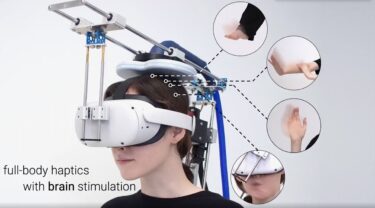Researchers at the University of Chicago have unveiled a device that uses non-invasive brain stimulation to simulate haptic sensations in different parts of the body.
Researchers Yudai Tanaka, Jacob Serfaty and Pedro Lopes call the device the “Haptic Source-Effector”.
The name is meant to emphasize that this is a centralized on-body haptic source, not the usual multiple haptic actuators worn on different parts of the body.
“We implement our concept via transcranial-magnetic-stimulation (TMS)—a non-invasive technique from neuroscience/medicine in which electromagnetic pulses safely stimulate brain areas,” the researchers write.
The device produces haptic sensations in various parts of the body, including the hands, arms, legs, feet, and jaw. The user’s sensorimotor cortex is stimulated by a magnetic coil that is mechanically moved across the scalp to stimulate the corresponding areas of the brain.
The researchers were able to simulate about 15 different haptic effects, including the recoil of a projectile, the impact of an object against the leg or hand, stepping on a box, and an explosion near the jaw.
The researchers also cite a number of limitations of the device: that it is too large and heavy for prolonged use, that the number of haptic effects is limited, and that the device is simply too loud.
You can read the full paper online.
A myriad of haptic approaches and devices for hands and bodies have been explored over the past decade, none of which have proven practical. Current VR products do not go beyond controller haptics, and even haptic vests are still a niche.
As interesting (or frightening) as the concept behind the Haptic Source Effector may be, turning it into a product and marketing it would be complicated to say the least.
And at the end of the day, you have to ask yourself if it’s worth the immense technical effort to get a little more haptics. The hurdle of putting on a VR headset every day is high enough for most people.
Source: Mixed News





